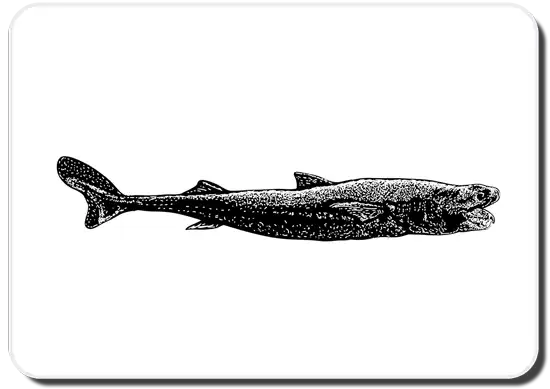The viper dogfish or viper shark is a rare species whose existence dates back about 41 million years ago. The species was discovered in 1986 off the southern coast of Japan.
The shark belongs to the family Etmopteridae and is the sole surviving member of its genus.

Viper Dogfish Scientific Classification |
|
| Kingdom | Animalia |
| Phylum | Chordata |
| Class | Chondrichthyes |
| Order | Squaliformes |
| Family | Etmopteridae |
| Genus | Trigonognathus |
| Scientific Name | Trigonognathus kabeyai |
Description
The longest male recorded was 1.5 feet in total length and weighed 0.95 lb, whereas the longest female was 1.8 feet long and weighed 1.7 lb.
Their cylindrical-shaped slender body is overall black with distinct darker markings containing photophores or light-producing organs on the underside. These photophores are also present in small amounts on the upper eyelid accumulated in a translucent patch.
The head of the viper dogfish is flat and with a short and blunt snout consisting of a pair of nearly vertical slit nostrils. There are narrow, elliptical spiracles present behind their large oval eyes.
They even have triangular jaws protruding from their head, alongside fang-like teeth, well-spaced in 6-10 rows in the upper jaw and 7-10 rows in the lower jaw.
The fins are small, thin, and translucent, and the tip of the caudal fin is blackish. The rear end of their pectoral fin is rounded and lobed, and they lack the anal fin.
Two spined dorsal fins (second dorsal spine longer) are also present between the pectoral and pelvic fins.
Where do they live
Map Of The Viper Dogfish Shark’s Habitat

Specimens of viper dogfish that have been studied were mostly found in the Kii Peninsula of Japan.
Their population is mainly found in the Pacific Ocean, in coastal regions of southern Japan- the Bonin Islands, the northwestern Hawaiian Islands, and northern Taitung County.
They inhabit different depths throughout the day. During the day’s warmth, these dogfish are present between 890 and 1,180 feet in depth. They may participate in diel vertical migration (cyclic movements where they move to the upper surface of the sea at night and return to the bottom daylight zone during the day), coming up to 490 feet deep during the night.
Behavior
Dietary
The viper dogfish feeds on bony fishes, lanternfish, and crustaceans like crabs, lobsters, and shrimps.
Reproductive
There is a distinct pairing with an embrace between the male and female viper dogfish. They are viviparous, bearing live young. Inside the mother, the young get nourished by the yolk during gestation. Adult females of this species have two functional ovaries and two functional uteri. The two female specimens that were recorded contained 25 and 26 mature ova.
While the maximum litter capacity does not exceed 26 pups, the average numbers are usually a couple of dozen pups in a litter.
Males and females attain sexual maturity when they’re roughly 17 and 20 inches long, respectively.
Adaptations
The numerous photophores on the body of the viper dogfish sharks glow and allow them to see in the darkness.
The ventral side of the shark’s skin is covered by small, flat V-shaped scales called dermal denticles that look like teeth. These scales make their skin hard and allow them to swim away fast.
This species captures its prey by impaling them with its sharp teeth. Its expandable and protruding jaws allow it to swallow large prey. This is the shark’s unique capability and is something that no other dogfish can claim.
Interactions with Humans
The IUCN has listed the viper dogfish as a ‘Least Concern’ species because of insufficient data about their population.
There also have been no reports of them attacking humans.
These dogfishes are localized and are of no commercial value; they are rarely caught by trawlers and fishing boats while catching other fishes.
